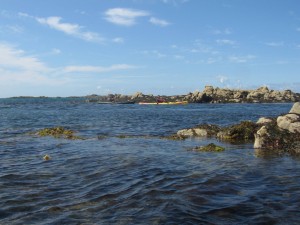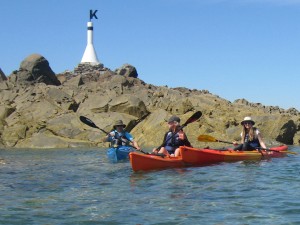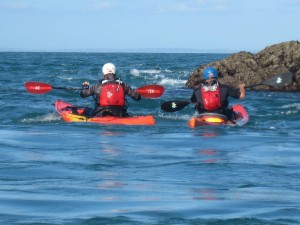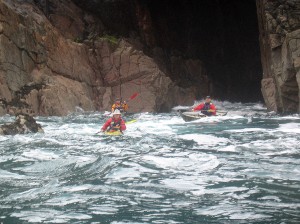Sea Kayak Visibility
How visible are sea kayakers?
I recently came across one of those dark green coloured kayaks. The sort that people buy because they think it will not scare the fish away.
What surprised me was just how hard it was to see them in comparison to another paddler fishing from a bright yellow kayak.
It’s not just sit-on-top kayak anglers, who buy dark coloured kayaks. Many sit inside sea kayaks can be bought in dark colours. Great for those wanting to go smuggling, but less good if you want to be seen.
High speed ferry collision
My concern was prompted by the report on the collision by the Condor Vitesse, with Les Marquises, a potter, in March 2011 off Jersey.(English version from p44).
2 minute warning
The ferry was travelling in thick fog at 36 knots with a radar watch. Between the time Les Marquises appears on the radar and collision there is less than 2 minutes warning. Sadly no one noticed.
The report identifies the speed of the Vitesse to be an underlying factor and that
“From 8:40:20 to 8:42:43 (collision time), both deck officers were talking together continuously about a topic without any interest for the navigation”.
If a high speed ferry travelling at 36 knots has less than 2 minutes to spot a 9m potter on the radar in between some random chat between the crew on watch, what chance do a couple of kayakers have in good visibility even from a slower moving vessel?
Put it another way: At 36knots a high speed ferry is moving at 0.6nautical miles per minute. It’s difficult to spot a sea kayaker at this range in any swell or chop even if you know what to look for. And this is assuming the watch hasn’t blinked or been distracted for a moment.
An experienced pilot recalls bringing a cargo ship into Jersey. He spotted the yellow kayak. Only as they went past did he see the dark one.
You may say that you don’t go near shipping lanes. However, large vessels often vary their routes.
Smaller motor cruises and Rigid Inflatable Boats (RIBS) move pretty fast around our coastline and close to shore.
Trying to spot things from a RIB is not easy, especially when it is as low as a kayak in the water. Rob Mousley of Surf ski infos rescue exercise writes “…the first thing that struck me was just how little visibility there is from a surface craft going upwind into a 25-30kt breeze! Sheets of water were sweeping over the bow of the craft and we could see virtually nothing”.
The sound of an approaching ship (even high speed craft) can be almost non-existent in some conditions so it is no good assuming you will hear it.
Sea kayaks are not expected in open waters or offshore
Venture more than a couple hundred metres offshore or out of a bay and many boat owners will not be expecting to come across kayaks. Just as I wasn’t expecting to see a lone long distance swimmer in the middle of St Brelade’s Bay last year.
Add a bit of swell and the skipper of a motor cruiser is going to be pretty busy staying on course and watching the swell. They do not expect to see kayaks between the swells in open water.
Best colours to use when sea kayaking
Surf Ski info South Africa organised a sea kayak rescue exercise in 2008.
The key finding is that red is easier to spot from the air.
At sea level the brightness of the paddler’s clothing is more important than the ski colour.
A metallic space blanket fluttering in the wind grabbed the helicopter crew’s attention.
Things to do to be more visible in a sea kayak
A signal mirror, even on a dull day, catches peoples attention. A CD is a good alternative. If you sea kayak in France a signal mirror is considered an essential item of kit by the authorities.
Brightly coloured paddles when moving are often spotted before the kayak-and are easier to spot if paddles drift away during a capsize.
- Buy a brightly coloured sea kayak.
- Consider adding reflective tape to your paddles.
- Wear bright paddle clothing instead of those nice subdued blues, greys and even blacks some designs favour.
- Use brightly coloured paddles.
- Carry a signal mirror.
- Assume a vessel has not seen you.
- Carry radio communication.
- Check if you are crossing shipping lanes or routes used by motor boats.
- Check ferry timetables. At least you’ll have an idea of when one may be in your area.
- Inform the Coastguard of your plans, especially if heading offshore.
Derek




